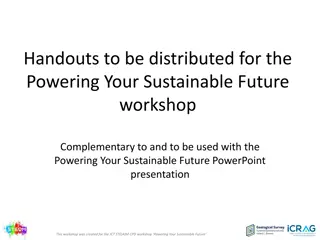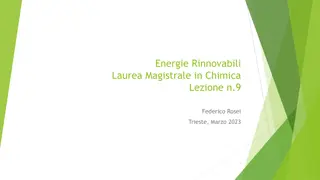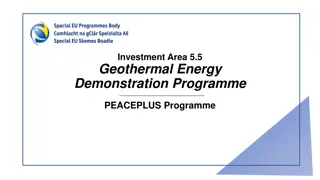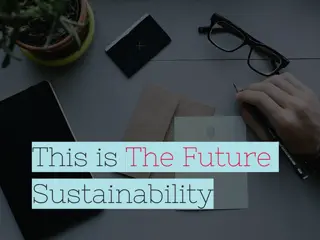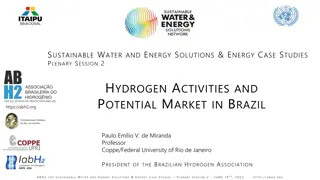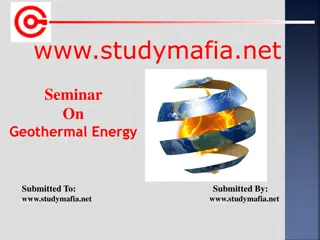Overview of Geothermal Energy in Europe
Explore the European Geothermal Energy Council (EGEC) and its initiatives to promote geothermal energy in Europe. Learn about key figures, market analysis, and targets for geothermal energy usage. Discover the potential of geothermal power plants in meeting Europe's heating, cooling, and power generation needs, along with advancements in technology and innovation through platforms like ETIP.
Download Presentation

Please find below an Image/Link to download the presentation.
The content on the website is provided AS IS for your information and personal use only. It may not be sold, licensed, or shared on other websites without obtaining consent from the author.If you encounter any issues during the download, it is possible that the publisher has removed the file from their server.
You are allowed to download the files provided on this website for personal or commercial use, subject to the condition that they are used lawfully. All files are the property of their respective owners.
The content on the website is provided AS IS for your information and personal use only. It may not be sold, licensed, or shared on other websites without obtaining consent from the author.
E N D
Presentation Transcript
EGEC European Geothermal Energy Council o Fondata nel 1998 Bruxelles o 30 paesi rappresentati o 180 membri developers fornitori tecnologia, utilities ed enti pubblici associazioni nazionali centri di ricerca geological surveys https://www.egec.org/
Overview (EU market report 2022) Some key figures 142 Geothermal electricity plants: 3,5 GWe installed and more than 22 TWh produced 395 geothermal District Heating systems in operation, with 14 new in 2022: 5,6 GWth capacity More than 2,19 million geothermal heat pumps in Europe at the end of 2022
Market analysis 1913 - 2023: Celebrating 110 years of geothermal power The oldest geothermal power plant is still in operation is from 1986. 4 running plants are from the 80 s, 17 from the 90 s and 32 plants run from the 2000 s. 21 power plants are more than 25 years old and 53 are more than 15 years old. The geothermal electricity market is now entering a new development phase, with many plants to be put into operation throughout the next 5 to 7 years. In total, today, 43 projects are developed and 140 are investigated.
Need of Baseload Capacity factor is the annual generation of a power plant (or fleet of generators) divided by the product of the capacity and the number of hours over a given period. In other words, it measures a power plant's actual generation compared to the maximum amount it could generate in a given period without any interruption [ScienceDirect] Average European capacity factor per electricity sources, 2022
Geothermal for Europe, targets to cover 25% of Heating and cooling demand 10% of Power generation Underground thermal storage for 50% of the District Heating Co-production of minerals: 20% of lithium demand Graphic courtesy EGEC
ETIP EU Technology Innovation Platform Geothermal https://www.etip-dg.eu/
Fit for 55 package measures for geothermal 1) financial risk mitigation frameworks for renewable heating: creation of risk mitigation frameworks (RES Directive) 2) Local authority mandate on RES H&C planning (Energy Efficiency Directive /RES Directive) Urban areas with a population of 45 000 inhabitants will be required to plan renewable heating and cooling networks.
REPowerEU Reacting to the energy crisis A plan to rapidly reduce dependence on Russian fossil fuels and fast forward the green transition. Key Measures for Geothermal: 1) target for the capacity of geothermal to triple by 2030 2) renewable go-to areas (to be included in the RES Directive revision): simplify permitting procedures 3) Fast permitting for geothermal heat pump systems (three months maximum) 4) Large skills partnership: geothermal needs DRILLERS !
RED III and Net Zero Industrial Act (NZIA) Key Measures for Geothermal (RED III): Key Measures for Geothermal (NZIA): 1) Simplifying the regulatory framework for net-zero technologies 1. Renewable energy sources (RES) share target is set at 42,5% by 2030, with plans to increase it to 45% in a non-binding manner 2) Scaling up manufacturing of net-zero technologies 2. Renewable go-to areas (RGTA) and Fast permitting procedure renewables (12 months max in RGTA, 24 outside) 3) Fostering competitive and resilient European net-zero industry for deploying 4) Geothermal Energy and Heat Pumps among the 8 Strategic net-zero technologies 3. Binding target for RES share in Heating & Cooling, with an annual increase: + 0.8% for 2021-2025 and + 1.1 % for 2026-2030 5) Net-Zero Industry Valleys, aimed at fostering industrial collaboration and encouraging MS to make targeted investments in specific areas within the EU 6) Proposal for MS to allocate 25% of Emissions Trading System (ETS) revenues for expenditure aimed at achieving the objectives of the NZIA. 4. From 2045 on both Waste heat recovery and RES will be the only energy sources allowed for Efficient District Heating Cooling
Governments going ahead anyway Hybrid Heat Pump Plan Risk guarantee scheme. Exploration and production licence law by 2024. Double Geothermal HP by 2025 & Geothermal DH by 2030 Risk guarantee scheme. Subsidies for heat pump purchase and support for DHC systems. 2billion given to geothermal deployment in May 2023 100TWh from 100 new Geothermal HP and Geothermal DHC systems by 2030. Focus on Geothermal HPs and DHC system 600,000 HPs by 2030. Expect half to be geothermal and DHC
Next steps Focus shifting to Member State implementation. Key areas are: National Energy & Climate Plans (NECPs): Member States will update by June 2024 their national policies and measures to meet the new climate and energy targets National geothermal strategies: France, Germany, Poland and Ireland issued national strategies for geothermal in 2022/2023 and are legislating now to mainstream it. Denmark, Finland, Netherlands and Hungary have support measures for geothermal district heating and heat pumps Renewable go-to areas : These identify where geothermal and other renewable plants can be built and a streamlined permitting process. Essential to use this as an opportunity for geological surveys to map geothermal potentials and capacity building for permitting agencies using the Life-cycle environmental impact assessment tool the Green Deal Industrial Plan to support investment in new capacity Geothermal lithium: support from the Critical Raw Materials Act and
The missing pieces of the jigsaw Harmonised financial risk mitigation: Germany and Poland preparing financial risk mitigation schemes as outlined in government agreements or national roadmaps. Netherlands updating SDG++. However, need to continue to advocate for an EU or regional financial scheme. Heat Purchase Agreement (HPA) market: Crucial for an industry-led approach to developing the market for geothermal HPAs based on power generation, cogeneration or trigeneration models. Geothermal Action Plan: In 2023 the geothermal industry is calling for a European geothermal strategy. EGEC is proposing to set up an industrial partnership, similar to those for hydrogen, biomethane and PV, to directly regulate the market for geothermal across the EU.





